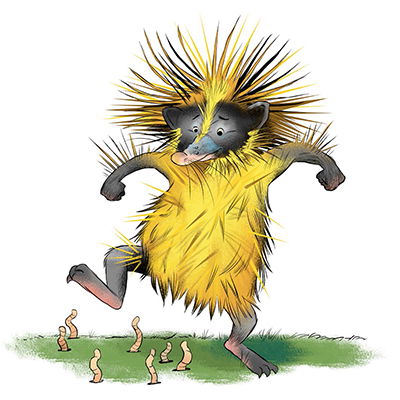Practical Prickles: Lowland Streaked Tenrec
Watch out—this critter’s outrageous hairdo is more than a fashion statement.
Think fast: what is noisy, stays up late, and sleeps late into the morning? Don’t answer yet—it also strays from its parents, sports an extreme hairstyle, and has a gnarly attitude.
No, it isn’t a teenager. Well, it could be, but here’s another clue: it’s an expert at thriving in the rainforest. You got it—it’s a lowland streaked tenrec! With a prickly exterior and a matching disposition, these crazy critters overcome the odds in a dangerous place. How do they do it? The secret is in the spines.
A What?
Tenrecs are small, shrew-like mammals. Even though some are dead ringers for hedgehogs, the similarities are only spine deep. In fact, biologists struggle to classify tenrecs. Creation scientists believe they belong to their own separate created kind. So why are their spines so similar to those of unrelated animals? Well, if the same Designer created hedgehogs, porcupines, and tenrecs, it shouldn’t surprise us to see his signature in such similarities. Still, lowland streaked tenrecs make unique use of their spines, as we’ll see.

Warning stripes and prickly quills tell predators the tenrec won't be an easy meal.
Lowland streaked tenrecs are found in and around the rainforests of eastern Madagascar. They’d fit in your hand, measuring around 7 inches (16–19 cm) long and weighing about 5 ounces (125–280 g). Every few hours (day or night doesn’t matter), they come scurrying out of their burrows to nose around for earthworms. If you find one hungry hunter, others probably aren’t far away, since they burrow and forage together as families.
They’re also super cute. But don’t get on their bad side—those outrageous hairdos aren’t merely a fashion statement.
Go Ahead, Make My [Hair] Day
Like hedgehogs, lowland streaked tenrecs defend themselves with their spines, but unlike hedgehogs, they don’t roll into balls. Their needle-sharp spines are equipped for defense in several ways. First, the colorful streaks are signs that these feisty critters won’t be easy snacks. If a predator ignores the warning colors, tenrecs raise the spines on their necks and heads, while sounding off with a “putt-putt” or a “crunch” and stomping their front paws.
If the attacker still wants to risk picking a fight, the tenrec gets rowdy. Bucking its head up and down, it charges. Tenrecs will charge at animals much larger than they are (for instance, the catlike fossa is up to 40 times larger). Like porcupine spines, the spines on the lowland streaked tenrec are barbed and wrapped in a sheath at the base so they can detach. A persistent predator is likely to get a face full of needles. Don’t say it didn’t warn you!
It’s an effective defense, but why would anything need defense in God’s original “very good” creation, when all animals were vegetarian? A clue may involve yet another feature of their spines.
Rubbing the Right Way
Tenrecs also use their spines to communicate with each other by stridulation. You may not have heard of this term, but you’re familiar with it because you’ve heard crickets chirping. Stridulation is caused by the vibration of two surfaces rubbing together, like a bow against violin strings (or a cricket’s wings against each other). Many insects make music this way, but tenrecs are the only mammals known to stridulate.
The lowland streaked tenrec sounds off with a special patch of spines designed for this very purpose. The instrument is located on a small area of its back. Underneath the skin is a complex, interlaced network of muscles that allows the spines to turn rapidly against each other. Some of these sounds are audible to humans, but much of their music is ultrasonic—too high-pitched for humans to hear. In fact, when scientists study them, they use equipment normally used for bats.
They may strike up a tune for various reasons. One is for the mother to corral her young. While foraging for food, the little ones may wander off. Like blowing a whistle for lost campers, she rubs her spines together to call the strays back to safety.
How did they become so brambly and boisterous? God placed immense variety in his creatures so they could fill the earth. It may be that tenrecs’ spines were originally designed for communication and became sharpened weapons only after Adam’s sin brought death into the world. In any case, about 1,700 years later, when members of the tenrec kind left the ark, they carried with them the DNA to thrive in a multitude of niches and “keep their offspring alive on the face of all the earth” (Genesis 7:3).
God shows his providence and care in all his creatures, even the prickly ones, and they sing—and stridulate—his glory in every corner of the world (Psalm 96:11–13).
Did You Know . . .

illustration by Dave Mottram
Tenrecs rub specialized spines on their backs together to produce high-pitched sounds—a form of communication known as stridulation. Insects like crickets stridulate by rubbing their wings together, but the lowland streaked tenrec is the only mammal with this ability.
Their body temperature is among the most variable of all mammals. It can swing widely in just hours and sometimes drops to almost as low as the surrounding environment.
They are particular about the conditions of their homes. They cover their burrow entrances with leaves and create a latrine near the door.
Tenrecs go to the bathroom in one place and can be potty trained as pets. They can also be trained not to stick their spines into their owners.
They have a few tricks to help find food, including stamping the ground to get the earthworms moving.

illustration by Dave Mottram
Answers Magazine
March–April 2018
The beach beckons us with its seashells. More than just ornate collectables, they testify to the Creator’s lavish provision for even the lowliest creatures. The Creator designed shells with mind-boggling features evolution can’t begin to explain.
Browse Issue
Answers in Genesis is an apologetics ministry, dedicated to helping Christians defend their faith and proclaim the good news of Jesus Christ.
- Customer Service 800.778.3390
- Available Monday–Friday | 9 AM–5 PM ET
- © 2026 Answers in Genesis



